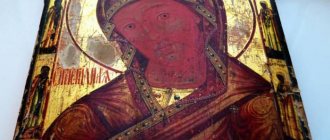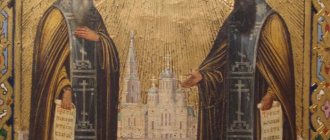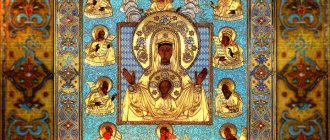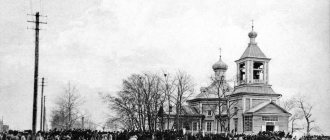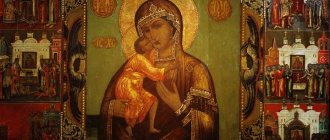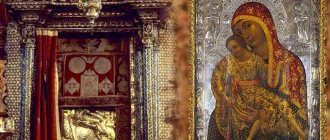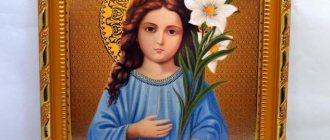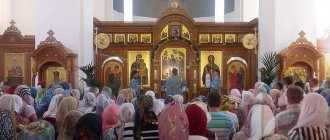Among the numerous miraculous images of the Mother of God, the Vilna Icon of the Mother of God occupies a special place. It has a very rich history, which dates back to apostolic times. She is also responsible for many different healings, simply helping in various human affairs. Today, a copy of this image of the Mother of God is located in Vilnius, in the Holy Spirit Monastery (and the original icon was lost after the events of the Civil War and the First World War).
History of icons in Rus'
There is no exact version of how the Vilna Icon of the Mother of God appeared in Rus'. According to one of them, this ancient image came to Moscow with Sophia Paleologus in 1472. The princess subsequently becomes the wife of John III. There is another version of how the icon ended up in Rus'. The Greek emperor sent it as a gift to the Galician king, and after the capture of the Galician principality, it passed to the Moscow ruler.
Be that as it may, in 1495, Princess Elena, daughter of John III, was blessed for marriage with this icon. She moved with her to Vilna, the capital of Lithuania. Obviously, this is why it was later named Vilna. While the princess was alive, the ancient image was in her chambers.
After Helena's death, which happened in January 1513, the shrine was placed over her tomb in the Assumption Cathedral in Vilna (this was stipulated in her will). It was the residence of the Lithuanian and Kyiv Metropolitan, as well as one of the oldest and most ancient churches in the capital. Some historians find confirmation that Elena gave this image to the temple in advance, and not from the moment of her death it ended up there.
An interesting fact is that the Moscow principality tried to reclaim this icon more than once. Many ransoms were offered for her, but all attempts were rejected.
Vilna Icon of the Mother of God
The Vilna Icon of the Mother of God is the oldest image painted by the Evangelist Luke. She is considered miraculous and revered by all believers.
Among all the Orthodox miraculous icons of the Mother of God, the Vilna Icon occupies an important place. The history of this icon is very rich and stretches back to the beginning of apostolic times. She is responsible for a huge number of healings and deeds that have more than once saved people drawn to faith and unity with the Lord.
History of the icon
The Vilna Icon of the Mother of God has a legendary history of its origin. It was written in ancient times, when Christ still walked the earth and the Virgin Mary was alive. For a long time, the shrine was considered a family icon in Constantinople. There is no exact version of how exactly the icon of the Mother of God appeared in Rus'.
According to historical reports, the Greek emperor sent the shrine as a gift to the king of the Galician principality, which was subsequently captured by the Moscow ruler. One way or another, the first mentions of the icon are found in sources dating back to 1495. This year, the daughter of John the Third was blessed for marriage with the Vilna Icon of the Mother of God. Together with Princess Elena, the shrine was sent to Lithuania, to the city of Vilna. Most likely, this is why it was named Vilna.
Where is the icon
Only copies of the Vilna Icon of the Mother of God have survived to this day. One of them, the most revered and prayed for, can be found in Vilnius, in the Holy Spirit Monastery. According to the clergy, they repeatedly wanted to return the icon to Moscow, but attempts remained in vain. The original was lost without a trace after the hostilities of the First World War.
Description of the Mother of God Icon
This image has many similarities with the Jerusalem, Tikhvin and Georgian icons. The shrine depicts the Mother of God with the Child of God in her arms. A distinctive feature of these images is the bare heel of Christ, which looks out. The Son of God holds a scroll in one hand and bestows a blessing with the other. The Holy Family is dressed in silver, and on the head of the Heavenly Queen there is a golden crown held by angels.
How does the Vilna Icon of the Mother of God help?
Over many centuries, the opinion has been established that the Mother of God acts as the patroness and intercessor of all Christians. People who have lost all support in life turn to her first. Believers offer prayers to the Mother of God, begging her for immediate help, intercession, and to transmit prayers directly to the Lord.
The Virgin Mary is, first of all, a caring and compassionate Mother, who graciously helps everyone. And all Christians perceive it as such, even far beyond the borders of our country.
Days of celebration
There are several days of celebration of this icon. The first one is February 28th. On this day, they remember the events when the icon of the Virgin Mary was transported to Vilna, where it received its name. The second is April 14. At this time, Christians pay tribute to the memory of all the martyrs of Lithuania. True, the main holiday of veneration of the Vilna Icon is considered to be the 28th - this day was established by the Christian Church.
Prayer to the Mother of God
The prayer of the Mother of God before Her image is known for its miraculous power. Most often, believers offer prayers through this icon, asking the Mother of God to alleviate or heal their ailments. This shrine is glorified by ambulance services. Also, the Vilna Icon can help in getting rid of sins and protecting from enemies. The Mother of God should be addressed briefly, without unnecessary words, with sincerity and faith in the heart:
“Intercessor of the faithful, Most Holy and Sinless Mother of God! We pray to You in front of Your miraculous image, do not turn away from us, Holy Intercessor and patroness of all Christians. Your help has saved us more than once, so hear our prayers to You. We need You and we cry to You: deliver us from all troubles and misfortunes, save our souls and help us come to the Lord. We will glorify Your name and Your help forever and ever. Amen".
The Vilna Icon of the Mother of God is of great importance for all Christians. Everyone turns to her help: both Catholics and Orthodox believers. On February 28, believers pay veneration to the icon, so clergy call on people to visit the temple of God and pray to the Mother of God, without whom there would be no salvation for all Christians. We wish you peace in your soul,
The history of the icon during the formation of Uniate rule
The Vilna Icon of the Mother of God, after the Brest Church Union was proclaimed, was transferred to the Church of St. Nicholas. This happened because the Prechistensky Cathedral, where the image was located, became Uniate, and the Orthodox tried to preserve the most valuable shrines in their faith. However, in 1609, the Church of St. Nicholas also went to the Uniates, so it was decided to return the Vilna Icon back to the cathedral.
Further events led to the fact that the Vilna icon ended up in the Holy Trinity Church of the monastery. After a fire in 1610 in the Prechistensky Monastery and subsequent repairs, the metropolitan see was moved to the Holy Trinity Church. According to some sources, it is said that they immediately took the icon with them; other evidence suggests that after the desolation of the Prechistenskaya Church, the image was transferred to the Trinity Church. Be that as it may, in 1652 there were already documentary references to the fact that an akathist was performed every Saturday in front of the Vilna Icon in the Trinity Church.
Subsequently, she was taken out of the city and the temple more than once during wars. For example, in 1654-1667, during the Polish War, and also in 1700-1721, during the Northern War. The first time they searched for her on the orders of the Moscow Tsar Alexei in order to return her, but she was never found.
In 1707, a new icon case was built for the icon (the previous one had disappeared a year earlier in a fire), and a few years later it was gilded. Attempts to transfer the image to the Russian Empire ceased, since it was not touched even after Vilna was annexed to Russia, as well as after the annulment of the union.
Since then she has been in this monastery, but she was evacuated during the First World War, her further path is unknown. In the church in Vilnius there is now an exact copy of the icon (also, by the way, miraculous).
Vilna Icon of the Mother of God
Icon of the Mother of God “VILENSKAYA”
The Vilna Icon of the Mother of God is an ancient image of the Mother of God, according to legend, painted by the Evangelist Luke. The icon was for a long time the ancestral shrine of the Byzantine emperors. According to the most common version, in 1472 the icon was brought to Moscow by Princess Sofia Paleologus, who became the wife of the Grand Duke of Moscow Ivan III. There is also another version, which does not find wide support, that the icon passed to the Grand Duke of Moscow from the princes of Galicia, who once received it as a gift from the Byzantine emperors. In 1495, the Grand Duke blessed his daughter Elena with this icon when she married the Grand Duke of Lithuania Alexander. In honor of the transfer of the icon to Vilna, a celebration was established on February 28 (February 15, old style). After Elena's death, the icon was placed over her tomb in the Prechistensky Cathedral in Vilna. After the conclusion of the Union of Brest, the icon passed to the Uniates. Subsequently, the icon was transferred to the Vilna Holy Trinity Monastery. Twice the Russian tsars tried to return the icon to themselves: during the Livonian War in 1569, they promised to release 50 captives for its return after the capture of Vilna in 1655 by the troops of Alexei Mikhailovich, on his instructions, the Vilna governor Mikhail Shakhovskoy tried to find the icon, but it was taken to the Uniate monastery in Krulevets (Königsberg). After the fire of Vilna in 1741, the icon was transferred along with the metropolis to the Holy Trinity Monastery, which was then at the disposal of Catholics. The Prechistensky Cathedral was given to the Uniates. In 1812 it suffered during the French invasion. In 1839, the Holy Trinity Monastery, together with the Vilna Icon, was returned to the Orthodox. From that time on, the Vilna Icon of the Mother of God replaced the lost OSTROBRAMIAN icon for the monastery. During the First World War, many shrines were evacuated from the front line, including the Vilna Icon. She, along with the relics of the Vilna martyrs, was brought to the Donskoy Monastery in 1915, and after that her further fate is unknown. In the monastery, located on the outskirts of Vilna, there is the Ostrobramsky Vilna Icon. Her image is not similar to the icon of Hodegetria. On it the Mother of God is depicted in full height; She stands on the moon, and above Her most pure head the holy angels hold a royal crown. See Ostrobramskaya Vilna Icon of the Mother of God.
Celebration
— February 15/February 28. — April 14/April 27.
Icon of the Mother of God “VILENSKAYA”
Prayers before the icon of the Mother of God “VILENSKAYA”
Before the icon of the Most Holy Theotokos “Vilna” they pray for relief and healing of their ailments.
Prayer to the Most Holy Theotokos before Her “Vilna” icon
To whom shall I cry, Lady? To whom shall I resort in my sorrow, if not to You, Queen of Heaven? Who will accept my cry and my sighing, if not You, Most Immaculate, the Hope of Christians and refuge for us sinners? Who will protect You more in adversity? Hear my groaning, and bow Your ear to me, the Lady Mother of my God, and do not despise me who requires Your help, and do not reject me, a sinner. Enlighten and teach me, O Queen of Heaven, do not depart from me, Thy servant, Lady, for my grumbling, but be my Mother and Intercessor. I entrust myself to Your merciful protection: lead me, a sinner, to a quiet and serene life, so that I may weep for my sins. To whom shall I resort when I am guilty, if not to You, the hope and refuge of sinners, inspired by the hope of Your ineffable mercy and Your bounty? About the Lady Queen of Heaven! You are my hope and refuge, protection and intercession and help. My most blessed and speedy intercessor! Cover my sins with Your intercession, protect me from enemies visible and invisible, soften the hearts of evil people who rebel against me. O Mother of the Lord my Creator! You are the root of virginity and the unfading color of purity. O Mother of God! Give me help to those who are weak with carnal passions and sick at heart, for one is Yours and with You the imam of Your Son and our God intercession, and by Your wonderful intercession may I be delivered from all troubles and misfortunes, O Most Immaculate and Glorious Mother of God Mary. The same with hope I say and cry out: Rejoice, full of grace; Rejoice, Delighted One; Rejoice, Most Blessed One; The Lord is with you.
Troparion, tone 4
Intercessor of the faithful, Most Blessed and Swift, Most Pure Virgin Mary! We pray to You before Your holy and miraculous image, that just as You bestowed Your intercession on the city of Moscow from ancient times, so now You mercifully deliver us from all troubles and misfortunes and save our souls, like the Merciful One.
Kontakion, tone 8
To the chosen victorious Voivode, as having been delivered from the evil, let us write thanks to Ti, Thy servants, to the Mother of God, but, as having an invincible power, free us from all troubles, let us call to Ti: Rejoice, Unmarried Bride.
Greatness
We magnify You, Most Holy Virgin, and honor Your holy image, for which You bestowed a wondrous victory on the Hagarians to the Orthodox.
Orthodox Church Holidays.
Vladimir Icon of the Mother of God - June 3, July 6, September 8. Bogolyubskaya Icon of the Mother of God - July 1. Theodore Icon of the Mother of God - March 27, August 29. Kazan Icon of the Mother of God - November 4, July 21. Murom miraculous icon of the Mother of God “Quick to Hear” - November 22. Icon of the Mother of God “Inexhaustible Chalice” - May 18. Icon of the Mother of God “Life-Giving Spring” - Friday of Bright Week. Iveron Icon of the Most Holy Theotokos - Tuesday of Holy Week, February 25, April 13, May 6, October 26 Icon of the Mother of God "Unfading Color" - April 16, January 13. Icon of the Mother of God “Gerontissa” - April 17. Icon of the Mother of God “Deliverer” - April 17, October 17.
Prayers to the Blessed Virgin Mary.
Russian icon.
Copyright © 2015 Unconditional love
Iconography of the image
To make this icon, four boards were cut - two cypress and two linden. In its writing, the image is very similar to the Jerusalem icon (obviously, this is precisely why it is sometimes called the “Jerusalem” icon). There are also similarities with Tikhvin and Georgian images.
In the icon you can see the Mother of God holding the Baby in her left hand. His heel is bare and exposed, his left hand rests on his lap with a scroll, and his right hand is raised in a gesture of blessing.
During its long stay in the temple, the icon was overgrown with offerings of precious materials. In 1677, a chased silver chasuble was made for the image. The clothes of the Mother and Child were in silver, on which eagles and flowers were depicted in gold. It is also clear that the background of the icon is made using the most skillful filigree technique. On the head of the Mother of God there was a golden crown, which was supported by gilded angels, and on the crown of the baby there were precious stones.
Against the background of the icon there were many silver tablets, as well as various precious jewelry (beads, pearls, precious stones, jewelry made of gold and silver). When the restoration, repair and cleaning of the image was carried out in 1866, a new frame was made from all the jewelry and silver that was removed from the icon, as well as new halos with diamonds and diamonds. They also made a bronze frame for the icon.
Prayer to the icon
The Vilna Icon of the Mother of God is very famous for its various miracles. What do they pray for in front of this image? Usually they offer prayers and requests to her to alleviate or heal their ailments, both spiritual and physical. It is these healings that this image is glorified. This is exactly what is said in the prayer-address to the Mother of God in front of this icon.
They also ask for protection from various misfortunes, for deliverance from sins, for protection from various enemies. There is a special prayer with which you can address the icon, but there is no separate akathist, troparion and kontakion for it.
Thus, based on everything described above, the Vilna Icon of the Mother of God is of great importance for all Orthodox Christians.
About everything
The Dalmatian icon is a copy (copy) of the icon “DORMITATION OF THE HOLY MORTON”. Named after the monk Dalmat, the founder of the Assumption Dalmatov Monastery in the Perm province. In the first half of the 17th century, the Tobolsk nobleman Dimitry Ivanovich Mokrinsky, leaving his wife and children, retired to the Nevyansk monastery of the Tobolsk diocese, where he accepted monasticism with the name Dalmat. Since he was distinguished by a high virtuous life, the brethren of the Nevyansk monastery wished to see him as their abbot. But the humble Dalmatian, avoiding this high and responsible post, left the monastery, taking with him the icon of the Dormition of the Mother of God. In 1644, he arrived in the Perm province and settled here in a cave, in the possessions of the Tatar Iligei. When Iligei learned that a monk had appeared on his lands intending to build a monastery, he and his soldiers went to the ascetic, intending to expel him. Iligei stopped for the night directly opposite the Dalmata cave, across the Iset River, hoping to unexpectedly attack him at dawn. At night, the Mother of God appeared to Iligei wearing a crown, a scarlet robe, and a flaming sword in her hand. She strictly forbade harming the monk and ordered him to be given land to build a monastery. After this vision, the Tatar humbly came to Dalmat and gave him land for a monastery. The monastery was attacked several times. In 1664, the monastery was burned by the Siberian Khan Divlet-Girey, but the miraculous icon of the Mother of God remained unharmed. In 1707, Archimandrite Isaac restored the monastery and built a stone church, where the miraculous image of the Mother of God was placed. After the revolution of 1917, the Dalmatian monastery was destroyed, the miraculous image disappeared without a trace. Currently, the Holy Dormition Dalmatian Monastery (now in the Kurgan region) is being revived, and a new Dalmatian icon of the Mother of God was painted for it.
Vilna Icon of the Mother of God
The Vilna Icon of the Mother of God was painted by the holy evangelist Luke. Celebrations of the icon take place on April 27 and in honor of the transfer of the icon to Vilna (Vilnius, Polish Wilno; until 1939 the official Russian name was Vilna) - February 28. For many years, the Vilna Icon of the Mother of God was the family shrine of the Greek emperors in Constantinople. On November 12, 1472, Zoya Palaeologus arrived in Moscow from Rome, who, after her wedding with the Grand Duke of Moscow Ivan III Vasilyevich (1440-1505), took the name Sophia. It is believed that she transported the icon to Moscow. In 1495, the Grand Duke of Moscow John III blessed his daughter Elena, who was marrying the Lithuanian Prince Alexander, with the icon. The icon was transferred to the capital of Lithuania, Vilna (modern Vilnius), where it received its name - Vilna. When Elena died, the holy icon of the Mother of God was placed in the Vilna Prechistensky Cathedral, above her tomb. History suggests that after the death of Helen, when family ties with Moscow were lost, the Russian tsars twice attempted to return the icon. For the first time in 1569, during the Livonian War, Tsar Ivan Vasilyevich the Terrible tried to return this miraculous icon to Moscow and offered King Sigismund 50 noble Lithuanian captives for it, but the king resolutely opposed this, because all the clergy, both Orthodox and Uniate, did not wanted to lose this treasure. In 1655, after the capture of Vilna by the troops of Tsar Alexei Mikhailovich, on his orders, efforts were made to find and return the shrine, but it had already been taken to the monastery of Königsberg. Over time, the icon of the Mother of God of Vilna was returned to Vilna, where it remained in the Prechistensky Cathedral until the mid-18th century. Subsequently, it was transferred along with the metropolis to the Holy Trinity Monastery, which was then at the disposal of Catholics. The Prechistensky Cathedral was given to the Uniates. Only in 1839 was the Holy Trinity Monastery, together with the Vilna Icon, returned to the Orthodox. From that time on, the Vilna image of the Mother of God replaced the lost icon of the Mother of God, called Ostrobramskaya, for the monastery. During the First World War, in connection with the threat of occupation of Lithuania by German troops, Archbishop Tikhon of Vilna and Lithuania (future Russian Patriarch) blessed the evacuation of all Orthodox shrines to Russia, including the Vilna Icon. She, along with the relics of the Vilna martyrs, was brought to the Donskoy Monastery in 1915. Subsequently, the icon disappeared, and its fate is unknown. The Icon of the Mother of God of Vilna is known for its numerous healings of the suffering. Before her they pray for relief and healing of serious illnesses. Prayer to the Most Holy Theotokos before Her “Vilna” icon, venerated in the Vilna Holy Trinity Monastery
To whom shall I cry, Lady?
To whom shall I resort in my sorrow, if not to You, Queen of Heaven?
Who will accept my cry and my sighing, if not You, Most Immaculate, the Hope of Christians and refuge for us sinners?
Who will protect You more in adversity? Hear my groaning, and bow Your ear to me, the Lady Mother of my God, and do not despise me who requires Your help, and do not reject me, a sinner. Enlighten and teach me, O Queen of Heaven, do not depart from me, Thy servant, Lady, for my grumbling, but be my Mother and Intercessor. I entrust myself to Your merciful protection: lead me, a sinner, to a quiet and serene life, so that I may weep for my sins. To whom shall I resort when I am guilty, if not to You, the hope and refuge of sinners, inspired by the hope of Your ineffable mercy and Your bounty? About the Lady Queen of Heaven! You are my hope and refuge, protection and intercession and help. My most blessed and speedy intercessor! Cover my sins with Your intercession, protect me from enemies visible and invisible, soften the hearts of evil people who rebel against me. O Mother of the Lord my Creator! You are the root of virginity and the unfading color of purity. O Mother of God! Give me help to those who are weak with carnal passions and sick at heart, for one is Yours and with You the imam of Your Son and our God intercession, and by Your wonderful intercession may I be delivered from all troubles and misfortunes, O Most Immaculate and Glorious Mother of God Mary. The same with hope I say and cry out: Rejoice, full of grace; Rejoice, Delighted One; Rejoice, Most Blessed One; The Lord is with you.
Troparion to the Most Holy Theotokos before Her “Vilna” icon, tone 4
Intercessor of the faithful, Most Blessed and Swift, Most Pure Virgin Mary!
We pray to You before Your holy and miraculous image, that just as You bestowed Your intercession on the city of Moscow from ancient times, so now You mercifully deliver us from all troubles and misfortunes and save our souls, like the Merciful One.
Kontakion to the Most Holy Theotokos before Her Vilna Icon, tone 8
To the chosen victorious Voivode, as having been delivered from the evil, let us write thanks to Ti, Thy servants, to the Mother of God, but, as having an invincible power, free us from all troubles, let us call to Ti: Rejoice, Unmarried Bride.
Greatness
We magnify You, Most Holy Virgin, and honor Your holy image, for which You bestowed a wondrous victory on the Hagarians to the Orthodox.
Ostrobramskaya icon
There is also an equally revered image in Vilnius, which is also sometimes confused with the one described above. It also has a rich and quite ancient history, and several options for its origin. This is the Vilna Ostrobramsk Icon, which is currently located in Lithuania, in the Ostra Brama chapel.
The origin of this icon is quite interesting. Some believe that this image was brought from Chersonese (Korsun), therefore in other sources it is also called the “Korsun Annunciation”. Prince Olgerd brought it from his campaign against the Tatars and gave it to his wife Maria. However, his second wife gave this icon to the Holy Trinity Monastery.
According to the second legend, the icon itself appeared on the Sharp Gate in 1431 on the fourteenth of April. There is also a third legend, according to which, the icon was sent by John Palaeologus to the Lithuanian prince Olgerd after he converted to Christianity. Thus, a miraculous shrine appeared on Lithuanian soil.
Story
Orthodox shrine
| Ostrobramskaya Icon of the Mother of God (XVI - early XVII centuries; without frame). Vilnius, Sharp Gates |
There are several legends about the origin of the icon.
According to the most widely accepted version, it was brought to Vilna from Chersonese (Korsun) by the Grand Duke of Lithuania Olgerd Gediminovich after one of his Crimean campaigns against the Tatars and presented by him to his first wife Maria. His second wife, Juliana, donated it to the Holy Trinity Monastery, which arose in Vilna on the site where the court boyars of Prince Olgerd, Saints Anthony, John and Eustathius, suffered from the Lithuanian pagans. The other two additions are less likely. According to one, the icon was sent to Olgerd by the Byzantine emperor John Palaiologos, when the latter learned of Olgerd’s adoption of Christianity. According to another, the icon miraculously appeared on the Sharp Gate on April 14, 1431.
In any case, in 1431 the icon was undoubtedly already in the chapel near the Trinity Church in the Russian, or Ostroy, end of the city of Vilna [1] and was called Korsunskaya
. She was celebrated on April 14 - the day of remembrance of the Lithuanian martyrs.
In April 1498, in view of the danger from the invasion of the Tatars, with the personal participation of the Grand Duke and his court, a new wall and gate was laid with a large tower at the Sharp end, called the “Sharp Gate” (in Polish “Ostra Brama”), on top of which was a chapel was built. The Korsun Icon was placed in this chapel, outside (on the south side), facing those entering the city. From that time on, the previous name of the icon began to be gradually replaced by a new one: Ostrovorotnaya
or
Ostrobramskaya
. When in 1495, the bride of the Grand Duke of Lithuania Alexander, the daughter of the Grand Duke of Moscow John III, Elena, brought with her to Vilna the Constantinople Icon of the Mother of God Hodegetria, this icon attracted predominant prayerful veneration, and the Ostrovorotnaya was somewhat forgotten.
In 1596, a church union was declared in the region, and the Holy Trinity Monastery, to which the icon and chapel belonged, along with all the buildings and the suburb involuntarily went to the Uniates. The pointed gate icon was taken by the Orthodox and placed in one of the parish churches, but in 1609 it was forcibly seized by the Uniates from the St. Nicholas Church and placed again in the chapel of the pointed gate, under the care of the Basilians who settled at the Trinity Church.
In the possession of Roman Catholics
| Vilna Ostrobramskaya Icon of the Mother of God |
Around 1624, a Carmelite monastery with the Church of St.
Teresia. Some time later, the Carmelites, taking advantage of the carelessness of the Basilians, took both the chapel and the icon into their own hands, and under their care the exclusive veneration of the Pointed Icon was resumed. In 1671, the Carmelites built a new chapel instead of the old dilapidated one and, installing an icon in it, turned it towards the church and the city, inside. After the terrible fire of Vilna in 1714, the icon was moved to the Theresien Church, but in 1744, with the restoration of the chapel, it was again placed above the gate. At the beginning of the 19th century, the Basilians tried to return the icon to their care, the dispute reached Rome, and the pope decided to leave the icon in the care of the Carmelite monastery, as it was closest to the chapel in which the icon is located.
In 1812, the icon was somewhat damaged by the French. In 1829, the icon was renovated in the Catholic spirit, and after removing the robe during the work, on the icon there was a song of praise to the Mother of God written in Slavic letters: “The most honorable Cherub and the most Glorious without comparison Seraphim.” With the closure of the Carmelite Monastery in 1832, the Terezin Church was renamed Ostrobramsky Church and remained under the jurisdiction of the white Roman Catholic clergy. Subsequently, the icon stayed in the chapel of the Sharp Gates of Vilna, in a huge icon case. The icon was covered with a gilded robe, as well as many metal offerings in the form of images of saints and various parts of the body, which testified to the benefits of the Mother of God to the human race. A Latin throne was built under the icon, on which at least two liturgies were celebrated daily. The icon is revered equally by Orthodox and Roman Catholics. According to the established custom in Vilna, not only Christians, but also people of other confessions bared their heads when passing through the Ostrobramsky Gate. You could always see people around the chapel, many of whom were standing right there, on the street, on their knees.
Modern veneration
In 2002, the only church at that time in honor of the Vilna-Ostrobramsky Icon of the Mother of God was founded in Kyiv, where prayer services began regularly before the revered copy of this image. Through the works of the rector of the temple, Archimandrite Jonah (Radzivil), an akathist to the Vilna-Ostrobramsky Icon of the Mother of God was compiled, which was accepted and approved by the Liturgical and Liturgical Commission of the Holy Synod of the Ukrainian Church on March 25, 2010 (published on the website of the Kyiv Vilna-Ostrobramsky Church,)


